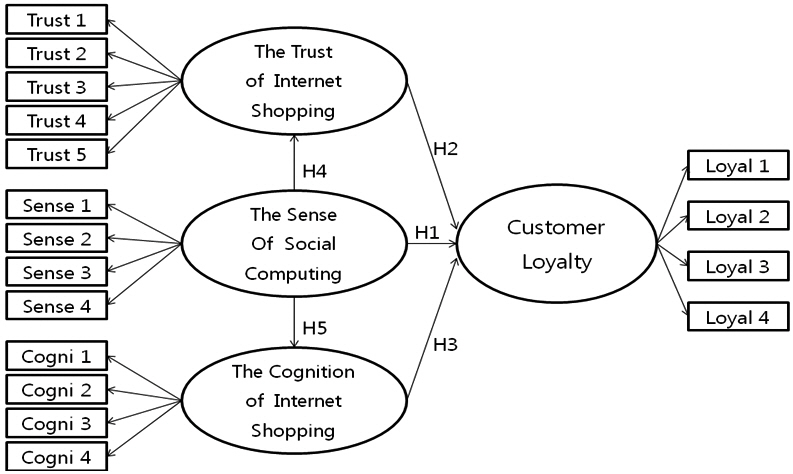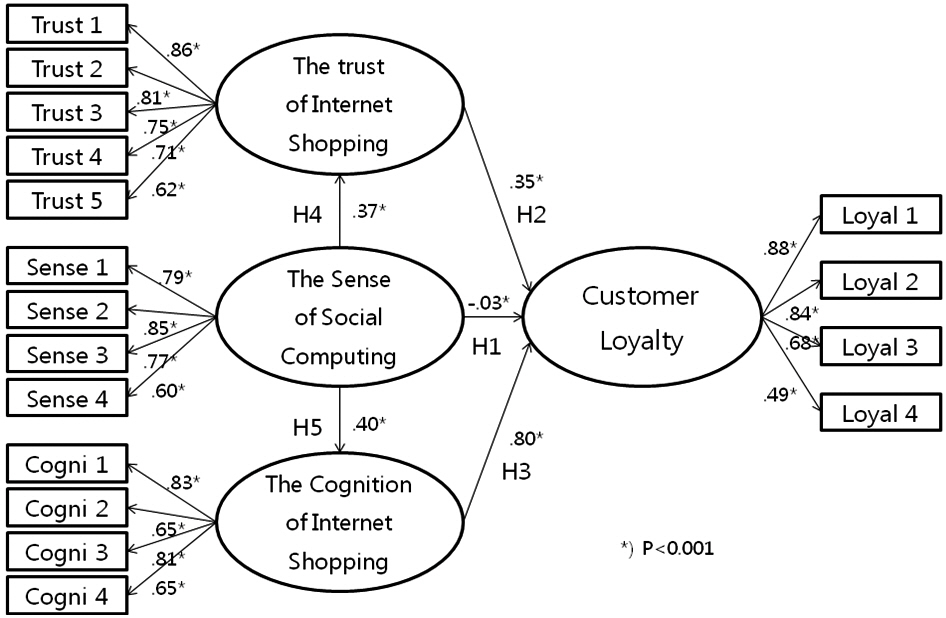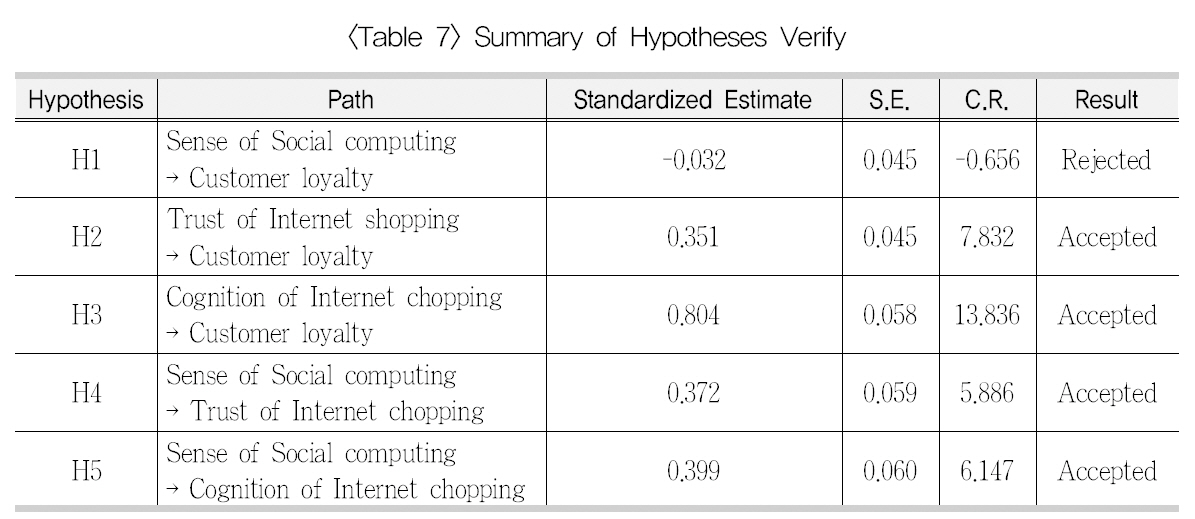


The appearance of Internet as a new form of information technology changes the social life style of people, one instance, people can get all information they want without any interruption of time and space. Also, the development of information technology also improves the globalization of the world. This change brought about the expansion of cyber space. It is defined that within cyber space,various members are participate in, as a space to enjoy fellowship, information, entertainment,emotional support and leisure activities without leaving one’s home, and is connected in one’s own convenient time and space.Expansion of cyber space is made to be a cyber community as an online community with the existing offline community. The traditional meaning of community is defined as “a social group of any size whose members reside in a specific locality, shared government,and often have a common cultural and historical heritage”, and the cyber community is generally defined as “a social group of any size whose members connected in the same network to interact with each other and to share information or interest in time”(William 2000). The cyber community on the Internet is not a world made by a minority, but it becomes a group for anyone to join. The reason for a cyber community is to be actively organized,and is not for profit, and it can be also said that the purpose and formation of the cyber community is to share information caused by human instinct to satisfy the most basic desire of human relationships and interaction with others(Rheingold 1992).
The activities of the cyber community and the concept of social networking services it created has developed into an idea of social computing. In wikipedia, social computing is defined as follows. ‘Social computing is called the use of social software which is a trend of information communication used with tools to support social interaction and communication. Using software and technology,it means that social concept and situation is created and re-created online.’ In fact, social computing is not so new. It is because the online revolution allowed a social relationship and communication in the group to be changed through e-mail or instant messaging from the beginning. Additionally,though blogs have already been commonly used, it is confirmed that there is a change to constitute a new community, exchange of individual idea and transfer of one’s opinion.Social computing is the next step in evolution for society. Currently, most CIOs are using social computing for internal workplace empowerment.Especially, as a part of a group,it largely succeeds in encouraging personnel empowerment. Consumer brand companies have looked at social computing as an alternative outlet and a “must try” in gaining new customers.
As online transactions become more active,the strategy to increase customer loyalty in Internet shopping is also effective for increasing profit for the company and it has become a method in maintaining its competitiveness On the other hand, shopping on the Internet shopping mall provides a value of experience that the existing offline retailers cannot provide. One example in point is that the buyer can purchase a product anytime and anywhere by just a click of a button. However, it is not easy for offline retailers to have contact physically with customers and competition is fierce with many other companies, because of the large selection of products. Thus, the company cannot take care of its customers as easily in order to be profitable. Because of easy access of Internet shopping malls, a lot of shopping companies are competitive with each other, as a result the effort of a company becomes more important to enforce the relationship with customers and increase the brand loyalty in shopping malls. This study is important in order to develop and understand the various relationships between customers and brand which is actively discussed in history(McAlexander et al. 2002; Fournier 1998; Price & Eric 1999). With the growth of electronic commerce,through the insurance of e-loyalty in the Internet, the company should establish the long term relationship with customers, so for this, it is important to have reliable relationships with customers(Reichheld & Phil 2000). It is suggested that it is important to make an environment for customers that is reliable and to know empirical factors such as emotion and trends of the customer in the Internet shopping because there are various methods for offline transactions.
Thus, in this study, looking at the existing research status for trust, cognition and customer loyalty in Internet shopping and social computing, based on this, after setting the research model, it is researched that how trust and cognition of Internet shopping and social computing are effective on customer loyalty in this exploratory theory.
The contents of this study are organized as follows. Chapter 1 presents a discussion of research background, objectives, scope, and this section. This is followed by Chapter 2,based on the existing literature, which presents the definition and discussion of social computing, trust of Internet shopping, cognition of Internet shopping and customer loyalty addressed in this research. Chapter 3 suggests research model and hypotheses. The research methodology used in this study to test these hypotheses is then described in Chapter 4.This is followed by a discussion of the results.Finally Chapter 5 presents the effect of social computing on customer loyalty in Internet shopping, the contribution of this study, limitation, and further research issues.
Social network service(Social Computing)is the name of so called social networking ideal among computers and sciences. As the concept of social networking formed online,it can be said that ‘through the Internet, the cyber community provided various types of social relations by accidental contact that formed an intimate relationship. A social network service is a field of computer science that researches about all social scientific issues happening in the web. A social network service is also known as social software such as wiki, blog, e-mail, bookmarks, widget, and so on, and as the trend of information and communication evolved the uses of these tools to support the social interaction and communication. At last, it is meant to create and re-create the social circumstance and concepts online using software and technology(Wikipedia 2009). In social network service,it is provided that social networking analysis to confirm the transaction procedure on the web, relation expansion tool to support formation of relationship through invitation,recommendation and acceptance without information editing tool, face to face activity and additional comment such as reply, wiki,information management tool and self expression like avatar and mini homepage(Dvorak 2004). Using these functions, as visiting each other’s home page, putting comment and reply, scrapping the information and sending the scrap to others, over the dimension of simply sharing information, it is to form and expand the relationship. That is,it is used as more actual relationship setting tool between people. As a result, recently,new types of services are continually outcome using social computing. For example,in Korea, the companies that open the mini homepage and make products known well know Cyworld already. As evolving the event providing the cyber money as a gift or company’s advertisement model in their mini homepage, it is recorded with outstanding traffic. Such a company as LG Cyon mobile phone, SK Telecom rainbow mobile phone and Pizza Hut develops this kind of activity.
Recently, it is known that a company should recognize the importance of online brand community and various effects as a contact to customers, and tries the best to use online brand community as a strategy tool for customer relationship management. As it is confirmed in cases of brand marketing successes using brand community, it is expected that the online brand community had a bigger effect to gather customers than the company’s own website because of its huge traffic. The preceding research associated with this kind of online brand community is mostly studied based on community loyalty and effects. For example, as a preceding factor to increase the community loyalty, it can be a community spirit or devotion, and it is shown that the positive effect will be given to attitude about relevant brand as increased as a preceding factor and the community loyalty(Lee 2007).However, in preceding research, it is shown that the relationship with customers is applied to be normalized for all kinds of users, which can be effective on the spirit of community without consideration of online community user’s individual characteristics. By online brand community user’s individual characteristics,the effort of relationship with customers provide on community sites can be different recognized, and it is expected that this difference is effective on procedure that forms community spirit which affects on community loyalty. For example, by individual need for cognition, preference of information media type can be different, and it can be shown that there is a difference of information process method when decision making(Cacioppo and Petty 1982; Haugtvedt et al. 1992), as well as this phenomena can be shown in use of social computing.
Trust is an expectation or faith that other could act with good will(Davis et al. 1998).In Cheskin Research(1999), it is reported that the reliability of electronic commerce is formed by insurance of safety, brand, search,satisfaction, and presentation. In this research,it is asserted that trust is a result of experience by time being. In online transaction,‘a lack of trust’ is acted as the worst obstacle to accept and use online shopping mall(Friedman et al. 2000; Tan and Thoen 2000). Li et al.(2006) is to realize using a variation as reliability in a lot of researches as a result of analysis of 31 actual proof researches reported in well known international journals for 2000 ~ 2004. The reliability is defined from the general concept of “something to be reliable is reliable?”, the beliefs of relier for specific sub-concept such as ability, benevolence,integrity, predictability and so on(Ba 2002).
According to the theory of personal relationships,it is said that interdependence and interaction with each other should be well done in order to establish sincere trust relationship between users and the website(Tan and Thoen 2000). Users depend on websites to satisfy the personal demands such as collecting product information or purchasing the products wanted, and it is interdependent with users for websites that are not only selling the company’s products but also to collect feedback, comment and review of users. In the procedure of purchasing the product and browsing the information on the website, it is interaction with website for users through feedback and review from others, participation of online community, chatting in time and so on. Through these interdependent and interaction, the condition should be suggested as follows, in order to have positive trust between the two.
First of all, the communication quality between shopping mall web master and users should be high. The communication quality is“to exactly and frequently share the information in right time through formal or informal path between two parties.” Communication quality on the web is done through recent technology such as FAQ, Help, file providing, personal information protect policy suggestion, answer for user’s question on time, chatting room, writing a massage feedback system and so on.
Secondly, the level of social shopping service should be high in order to actively establish sharing of information and participation between shopping mall participants.The interdependent and interaction between users and shopping mall should not be done between customers and seller, but as of today entering the web 2.0 generation, it has become more important design point in order to improve the reliability of shopping mall that‘allowing customers to exchange review,criticism and information to each other about product information.’
Thirdly, shopping mall manager should not act as opportunistic behavior. Opportunistic behavior is pointed as principal offence to reduce the trust that “action that offend or break the proper action required in viewpoint of others to have a relationship.” In the environment of use of Internet shopping mall, the opportunistic behavior of seller is associated with safety that Internet shopping mall follows and stand for as an action that mainly leaves or leads potential danger of online transaction(e.g., Disclosure of personal information,Internet evil intention selling, delivery delaying etc.). It is the key factor to increase the high safety and reliability of Internet shopping mall.
Among company’s various information services fields, functions such as homepage,DM or online community is a type of cognition service directly providing to customers,so it can be seen as a factor that is influenced on customer loyalty and company image, and the company image can be defined as cognition for company imagined in customer’s thinking(Keller 1993). Recently, the reason of increasing the importance of company image is because company image is applied as important axis to form brand equity of company with concept with brand awareness or brand association about company(Rest et al.2000).
Cohen et al.(1955) defines cognition need as “by a meaningful and integrated method,as a need for facing circumstances to be systematic,a need of understanding and rationalizing experienced world”, and Cacioppo and Petty(1982) conceptualizes cognition need as “a propensity that persons enjoy and think”, and it is adopted in consumer acting research developing a tool to measure this kind of research concept. Cognition need properties are represented to be effective on consumer action such as personal information cognition, media selection and a type of Internet use. It is shown that people who have high cognition desire usually do the center path process, and lower group does the peripheral path process(Cacioppo and Petty 1982). Haugtvedt et al.(1992) said that people who have higher cognition form their attitude more based on the evaluation of product properties than lower people group, on the other hand, people with lower cognition form depended on simple peripheral clues provided in such as advertisement. On the other hand,Thompson et al.(1993) has shown that cognition desire propensity becomes the negative correlation between high cognition desire and outer compensation as variance to control outer compensation effect. Recently, in the study about effect of cognition desire and web personalization service web users, it is shown that personalized recommended service effect is increased as higher cognition desire(Tam and Ho 2005). A person with high cognition desire level forms the brand attitude by the effort to find information and product information to understand a casual relation of event and stimulus by oneself, on the other hand a person with low cognition desire tends to form an attitude with extra information or psychological factors other than product information, and to depend on experts other than finding information by oneself(Cacioppo and Petty 1982). In the research of Crowely and Hoyer(1989), it is described that a person with high cognition desire tends to be interior aimed but a person with low cognition desire. It is because it is shown that a person with high cognition desire tends to satisfy the personal intellect desire other than communication with others.Thus, it is expected that a person with low cognition desire forms higher community spirit through interaction with other involved in community not to satisfy the personal cognition desire.
As concluded the preceding research associated with cognition shows that with desire,a person with high cognition desire searches the information a lot in any circumstance in order to satisfy their intellectual effort in any circumstance in order to understand different facts among the vast mass of media. Especially,the reason is to focus on personal property variances such as cognition and desire,because it is used to properly maintain the customer relationship which is established to analyze the key customers with personal characteristics which is known as the personal variance control effect in the peripheral path and center path by product and service information when the customer attitude is formed(Lee 2007).
In the early 1900, the concept of customer loyalty academically dealt in Harvard is researched as key preceding factor to decide the consistent financial achievement and growth of company in the field of all of current business management(Agustin and Singh 2005). Customer Loyalty is a “deep devotion using and repurchasing favorite service and product consistently in the future”(Oliver 1997), and “various kinds of action tendency to improve the relationship with supplier consistently”(Agustin and Singh 2005). Oliver(1999) defines loyalty as a customer’s commitment to repeatedly purchase the certain brand or product in the future without changing to another service or product despite all circumstances around. The loyalty can be defined on the aspect of action. Because the aspect of attitude is very personal, it is usually measured with re-purchase intention, recommend intention, amount of purchase and frequency,and sometimes it is measured by only re-purchase intention(Reichheld 1993). Customer loyalty is a status for customer to continuously use the Internet shopping mall with love. Loyalty is composed of degree of possessiveness, repeated purchase and visiting associated with brand, product, store or company(Griffin 1996).
In the literature of marketing, customer loyalty is researched in integrated viewpoint with both attitude and behavior viewpoint.Viewpoint of behavior is seemed as “a tendency to repeatedly purchase for certain period for the consumer in certain retail store” and is measured by re-visiting frequency, repeating purchase ratio and purchase frequency.The viewpoint has a merit that customer loyalty can be compared, on the other hand there is also a disadvantage that it is hard to explain how the customer loyalty forms and changes(Raj 1982). Viewpoint of attitude defines customer loyalty as “a favorite attitude for certain retail store” with preference for retail store and psychological devotion. The viewpoint is possible to explain how customer loyalty forms and changes but there is a disadvantage that cannot be sure to be continued to purchase in the future(Oh 1995).Also, viewpoint of attitude is very personal and projective, so it can not be measured realistically. Thus, customer loyalty is measured by re-purchase intention, recommended intention, purchase amount and frequency on practical aspect(Reichheld 1993). Integrated viewpoint is to combine these two viewpoints to emphasize to consider attitude and behavior at the same time. That is, purchase behavior that is not influenced on attitude is different from customer loyalty. Bloemer et al.(1999) analyzes customer loyalty into behavioral,attitudinal and cognitive in concept.Behavioral access method is measured as traditional re-purchase or continuous purchase,on the other hand customer loyalty of attitudinal aspect is shown as a degree of recommending to another, and cognitive access method is expressed as product or service that firstly occurred in thought.
The problem about how it can be measured and definition of customer loyalty also become important(Kim et al. 2008). Cronyn and Taylor(1992) used only “re-purchase intention”as loyalty measuring variable, but Boulding et al.(1993) adds ‘recommend intention’with ‘re-purchase intention.’ Also, it is found that using measuring category of 13 kinds of behavioral intention in 4 kinds of dimensions suggested by Zeithaml et al.(1996),as a result of positive research, customer loyalty for service is composed of 4 dimensions of ‘orally informing activity’, ‘purchase intention’,‘sensitivity of price’ and ‘dissatisfaction behavior.’ Concept and measuring method about customer loyalty are different by scholars, but it is known that there are‘purchase intention’ and ‘orally informing effect’mostly in all researches(Kim et al. 2008).
In the reality with extreme competition, insurance of new customers needs 5 times more of cost than to maintain the existing customers,and it is asserted that 24~85% of profit increased is caused for each company by increasing 5% of customer loyalty(Reichheld and Sasser 1990). Customer loyalty is becoming more important as a concept online with characteristic of online business that could make the customers lose easily.
3. Research Model and Hypotheses
Based on literature research until now the model of research is set up shown in <Figure 1>. This study analyzed how effective social computing and trust and cognition of Internet shopping are on customer loyalty. In the model of study, customer loyalty as dependent variable is divided into the sense of social computing, the trust of Internet shopping, the cognition of Internet shopping, customer loyalty,and effective factors are analyzed by factors through 5 different kinds of hypotheses.
The online community is defined as a group of people who interact each other with common interest and experience composed on the network by new information technology different from concept of community(Rheingold 1998). Also, as seen online community as a computer media place integrating with contents and communications created by members, this kind of online community can be used as a marketing tool for business(Armstrong and Hagel 1996). As seen recent research associated with this, it is positively shown that the content of online community,reputation, quality and size can be influenced on the devotion of customers, trust and loyalty as positive effect. In the research of McMillan and Chavis(1986) about community spirit, it is thought as divided into 4 kinds of sub-dimension of community spirit such as involvement, effective power, unification and satisfaction of desire and a share of emotional relation, and the community spirit is expressed as a sum of each factor. Through this community spirit, it is shown that it is positively influenced on community loyalty such as frequent visiting of community users, oral activity as community advertisement and subscribes recommend, positive active in the community, and continuously using intention for the community(Kang et al. 2007). Customer loyalty is a status for customers to use Internet shopping site continuously with possessiveness.Loyalty for the company, retail store, product or brand is composed of degree of possessiveness and repeating purchase. In the Internet environment, it is hard to maintain the customers for long term because of easy entry and exit(Rosenberg et al. 1983).Loyalty with are valued closer for profit within the company which is defined as customers having the tendency to have possessiveness for certain brand name, retail store and company(Kotler 1997). As company insures loyalty of consumers, in advantage obtained, there are 6 factors such as failure cost reduction, more positive oral effect,brand name sale success increased, consumer turnover cost decreased, transaction cost decreased and reduction of marketing cost(Griffin 1996). In the existing study of marketing,it is represented that the existing customer management is more effective than making new customers, and customer loyalty as quality achievement index is more associated with company profit than quantity achievement index(Zeithaml et al. 1996). In case of Internet site, customer foundation has to be insured by increasing loyalty of customer,it can be survived under very competitive environment(Reichheld 1993).
As brand loyalty is increased, customer can not be led by product of competitor or price change. In brand loyalty, there are two factor purchases and attitude. The loyalty of website is considered because the cost is much spent and acquirement of new customers is hard online. Here, the stickiness of website is suggested as a concept. That is, it is ability for customer to stay longer, travel seriously and visit frequently. Thus, it is suggested that the degree of stickiness includes 3 kinds of factors such as the stay time, visiting depth(quantity of this webpage) and frequency of visits(Hanson 2000). The existing customers with high loyalty frequently purchases more amount, and it is big role to increase the company profit incoming new costumer by positive oral effect and consistently re-purchasing even in high price with less sensitive for cost induction of competitive company(Aaker et al. 1990). Based on argument above, the theory can be set up as follows.
H1 : The sense of social computing has a positive effect on the customer loyalty.
H2 : The trust of Internet shopping has a positive effect on the customer loyalty.
H3 : The cognition of Internet shopping has a positive effect on the customer loyalty.
H4 : The sense of social computing has a positive effect on the trust of Internet shopping
H5 : The sense of social computing has a positive effect on the cognition of Internet shopping
3.3 Operational definition of research variables
In the study, based on already verified measuring tool in former researches, the measuring tool is developed modifying survey categories suitable to the study. There are involvement, effect, satisfaction of need and desire and intimacy as measuring question of sense of social computing(McMilan and Chavis 1986), there are belief for shopping mall,
[Table 1] Measuring Question and Operational Definition
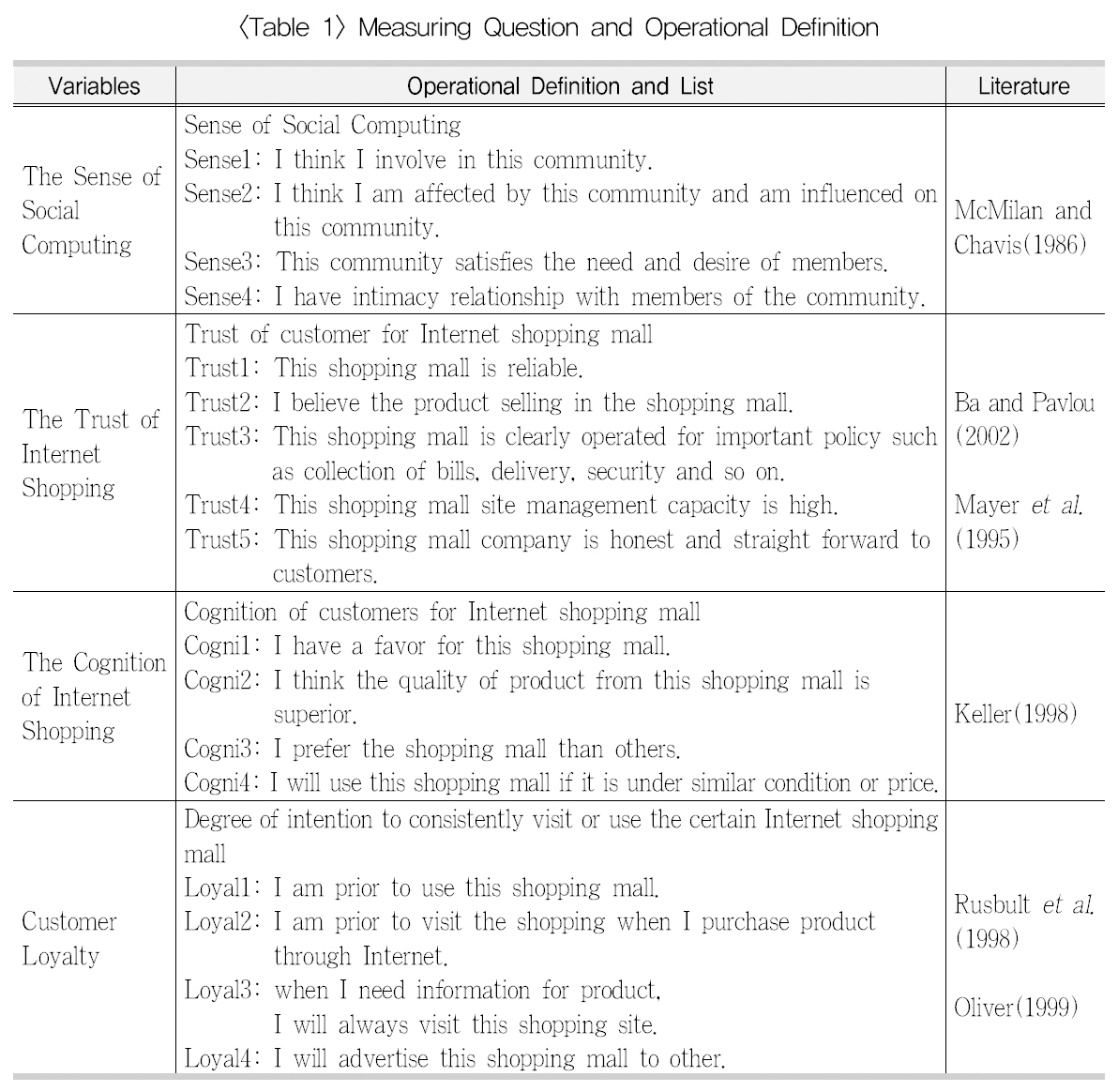
Measuring Question and Operational Definition
trust for product, delivery, insurance and capacity for site operation as measuring question of the trust of social computing(Ba and Pavlou 2002; Mayer et al. 1995). Also, there are good will and quality of product as measuring question of the cognition of social computing(Keller 1998). And it is said of intention to advertise to other, intention to use and consistent visits as measuring question of customer loyalty with dependent variable of the study(Rusbult et al. 1998; Oliver 1999).Measuring question and technical definition are shown in <Table 1>.
4.1 Data Collection and Measurement
The information collection of this study is to collect 335 surveys of 400 surveys distributed to 200 university students and 200 people who have experience with the online community and Internet shopping. Among them, except 9 of the surveys were unavailable,326 surveys were used for analysis.Information research is executed with method of surveying over 3 weeks from Oct 26th 2009 to Nov 15th. University students completed
[Table 2] Survey Collection Status

Survey Collection Status
the survey during break in class, and the general survey was completed from the general education trainee and members of online community. General education trainees from the culture center did the survey, and we received the survey results via email for online community members. We tried to have the survey age distribution consistent in order to avoid the disadvantage of focusing on certain age groups.
Among 326 surveyed, men is 229(70%),women is 97(30%), under 19 is 14(4.3), 20s is 155(47.5%), 30s is 26(8.1%), 40s is 66(20.2%), 50s is 65(19.9%). The results of the survey collection are shown in <Table 2>.
As a unit of analysis of the study is certain Internet shopping mall and community, Internet shopping mall and community should be selected by answerers, afterward opinions of user are measured as 5 points for Internet shopping mall and community.
In the study, Cronbach’s alpha is used to
[Table 3] Results of the Reliability Analysis

Results of the Reliability Analysis
[Table 4] Factor Analysis Result of Dependent Variable(N=326)
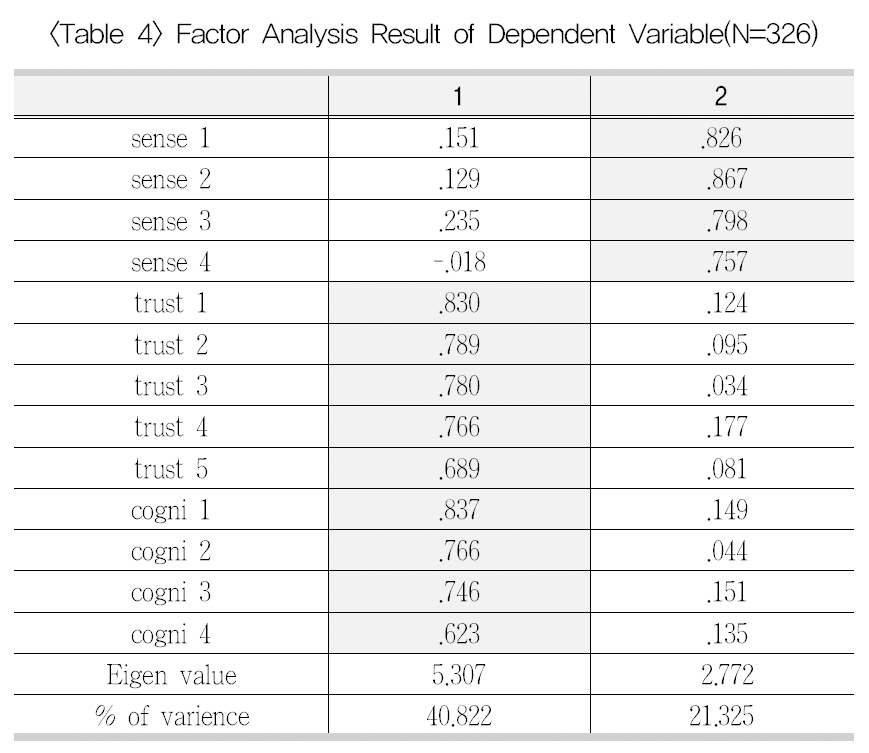
Factor Analysis Result of Dependent Variable(N=326)
verify internal consistency for variables in order to analyze the reliability of materials collected. Cronhbach’s alpha value is to inform how the sum of extracted variables from the standard is reliable for the true value of assumption in certain group as a statistic value to how reliable, it is an official approval for the question of that various kinds of variables measure all same candidate. There is no regulation about the significance of
[Table 5] Factor Analysis Result of Dependent Variable(N=326)
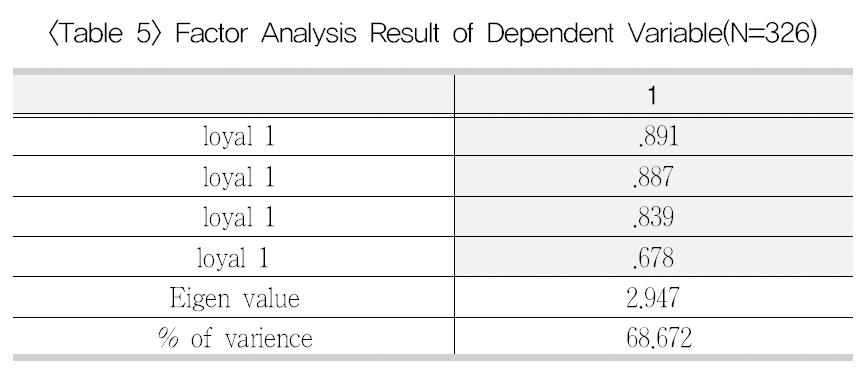
Factor Analysis Result of Dependent Variable(N=326)
Cronbach’s alpha value, but generally based on 0.6, it is a level to be satisfied in social science. In the study, it is represented that all factors have reliability of measuring category as the alpha value is more than 0.6 as shown in <Table 3>. Also, the factor analysis is executed to confirm that survey categories to measure each potential variables of study model statistically binds as the same factor.Extracting method by a factor uses principal component analysis, and rotation method uses varimax method. At this time, the factors with more than 1.0 Eigen value as a standard of evaluation to confirm collecting validity,and if factor loading is more than 0.5, it is regarded as significant(Joseph 1979). In the study, factor capacity of all questions are more than 0.50 as range of 0.623~0.891.Factor analysis result of the dependent variable is shown in <Table 4>, and Factor analysis result of the independent variable is shown in <Table 5>.
In the study, SPSS 16.0 is used to analyze the validity and reliability of variables, and AMOS 16.0 is used to verify the fidelity analysis and theory of study model. AMOS is used to verify the relation between the sense of social computing, the trust of Internet shopping, and the cognition of Internet shopping,customer loyalty. Also, it is verified how the sense of social computing, the trust of Internet shopping, the cognition of Internet shopping are effective on customer loyalty,and then how the sense of social computing is effective on the trust of Internet shopping and the cognition of Internet shopping. AMOS describes the study model covariance structure analysis is needed through path analysis.Path analysis is to set up relation with some direction between the variables and to suppose the linear regression method between variables thought as having relation, as impact on the path linked to each variable is qualitatively assumed. That is, the number of relations and same amount of description equation are made. From the data, path coefficient is assumed and by the value, strength of correlation is assumed.
Based on the reliability and validity verification result of measuring tools, fidelity index as <Table 6> and path diagram as <Figure 2> are yielded as a result of executing AMOS which is structure equation model program for former set-up research model. The fidelity index of the study model as shown in <Table 6> is evaluated as a level of acceptance.
Generally, the evaluation of goodness of fitness to evaluate the proper set-up structure equation model uses the whole evaluation standard. In AMOS analysis, it uses χ²(Chisquare),GFI(Goodness of Fit), Adjusted GFI, RMR(Root Mean-square Residual),
[Table 6] Fidelity Index of Research Model
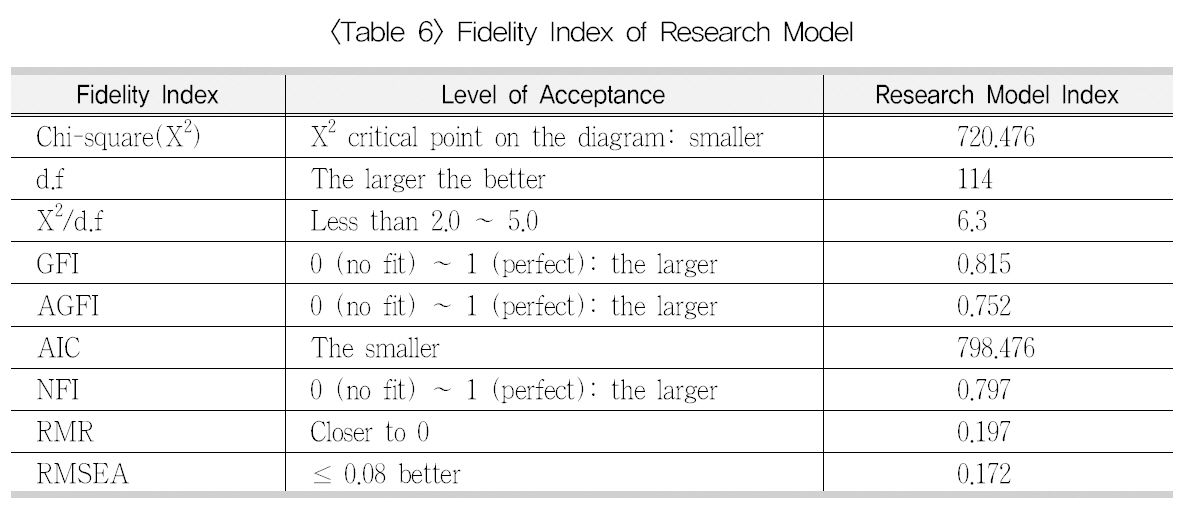
Fidelity Index of Research Model
NFI(Normed Fit Index), AIC(Akaike Information Criterion), RMSEA (Root Mean Square Error of Approximation) to evaluate the goodness of fitness, and then first of all, it corresponded as a smaller value, as Chisquare value is used to evaluate how study model corresponded to material, and if it is more than 0.8, it is regarded as well model,and if it is more than 0.9, it is regarded as superior model for both GFI and AGIF.RMR is different for recommended acceptance standard between the cases of input correlation matrix between the variables and using covariance matrix as input matrix, and it is regarded as well model if it is closer to 0(Chin 1998).
The result of path analysis through AMOS is shown in <Figure 2> organizing structural mode with customer loyalty as result variance,former variables such as the sense of social computing, the trust of Internet shopping,the cognition of Internet shopping.
As a result, it is represented that the trust of Internet shopping and the cognition of Internet shopping are significantly effective on customer loyalty, but the sense of social com-
[Table 7] Summary of Hypotheses Verify

Summary of Hypotheses Verify
puting is not significantly effective. Especially,as the factor mainly effective on customer loyalty is the cognition of Internet shopping (.80),through advertisement and public information,it is interpreted that reputation of Internet shopping is largely effective on the customer loyalty. Afterward, the trust of Internet shopping(.35) is effective. It is represented that the sense of social computing (-.03) is not significantly effective customer loyalty because the social computing is not mature to be effective on loyalty. However, the sense of social computing is significantly effective on both the cognition of Internet shopping (.40) and the trust of Internet shopping (.37). Social computing is not mature to be effective on customer loyalty yet, but it is effective on trust and cognition of Internet shopping.
In the Internet shopping, this study is verified by survey data with customer loyalty as a result of these variables which are the sense of social computing, the trust of Internet shopping, the cognition of Internet shopping as former variables, and organizing e-loyalty mode. As a result, the trust of Internet shopping and the cognition of Internet shopping are significantly effective on Customer Loyalty but the sense of social computing.Especially, the factor most effective on customer loyalty is the cognition of Internet shopping. Through advertisement and public information, reputation of Internet shopping is significantly effective on customer loyalty.It is represented that the sense of social computing is not significantly effective customer loyalty because the social computing is not mature to be effective on loyalty. However,the sense of social computing is significantly effective on both the cognition of Internet shopping and the trust of Internet shopping.Social computing is not mature to be effective on customer loyalty yet, but it is effective on trust and cognition of Internet shopping. The implication is provided for Internet shopping site what to do to increase the customer loyalty. That is, it is important to enforce the trust and cognition of Internet shopping in order to increase the customer loyalty, and for this, it is known that participation for social computing and consistent management are needed.
On the other hand, as seen in the results of this survey for customer loyalty, it is shown that the path coefficient is low in the recommendation for others but high in purchase for oneself. Thus, in case of recommendation to others such as friend or family,it is needed to offer proper incentives to increase customer loyalty.
Another implication of this study is that the concepts of social networking services and social computing which is combined with Internet shopping, the basis of this study is prepared as a future of social shopping. Now,Internet shopping is not meant that customers are satisfied to buy products desired through shopping, rather shopping as an interaction which is enjoyable with people rather than displaying shopping as an act of doing, a means to purchase products for use. Through social computing, social shopping is defined as the one word that shopping is meant to share with others and with wisdoms from others(Umeda 2006). That is, the basic concept of web 2.0 standing for participation,disclosure and share is applied in shopping.In short, the users are to share the information and participate in all procedures for shopping as registering interesting product,seeing other’s comment, writing a review,getting a recommendation, seeing behind the story of product buyer and to know what is popular these days. The importance of social shopping is suggested in theory associated with interpersonal influence early. Interpersonal influence is said that the tendency to study for the product/service based on information obtained by other’s behavior and other(Bearden 1989). In the field of marketing,interpersonal influence is regarded as a key factor to decide the customer’s behavior(Bearden 1990). In the psychological base depended on other’s opinions to purchase, the motive of validity to give is placed for purchase behavior.
The limit of the study is a problem of a survey candidate type of representative. Decreasing the bias of case, it is trying to organize the age group to be various, but if the type is changed, it is to have anxiety to be effective on the result. Also, to increase the accuracy of data, it cannot be specifically analyzed for each of detail factor as simplifying number of survey questions.
In the future study, reflecting that the interest of customers are increased for social computing, it is needed to re-verify with same topic how social computing is effective on customer loyalty and how the relationship between the trust of Internet shopping and the cognition of Internet shopping is changed.Also, it is needed to develop study in various angles for social shopping.
